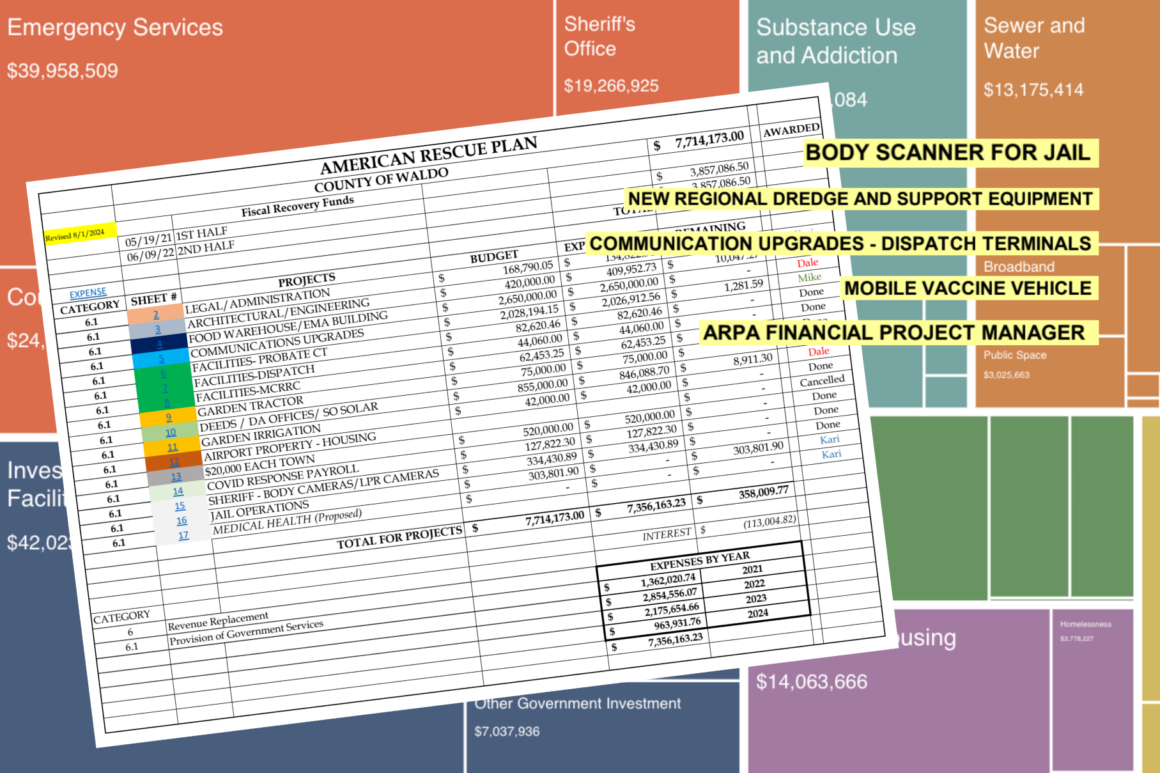Maine counties received $261 million through the American Rescue Plan Act (ARPA), which pumped billions in federal funding into Maine to help government agencies respond to disruptions caused by the COVID-19 pandemic and invest in critical infrastructure. The deadline to obligate these funds was December 31, 2024, and the deadline to spend them is December 31, 2026.
The U.S. Treasury Department directed local governments to use the funds to replace lost public sector revenue; respond to the pandemic’s public health and economic impacts; provide additional compensation for essential workers; invest in water, sewer, and broadband infrastructure; provide emergency relief from natural disasters; support transportation projects; and support community development programs.
This dashboard details how the state allocated nearly $1 billion through the Maine Jobs and Recovery Plan. Counties’ spending decisions have proved harder to track. Because county governments in Maine perform fewer functions than counties in many other states, there is less infrastructure to oversee the funds — which for many of them represented an unprecedented windfall.
The Maine Monitor reached out to representatives from all 16 counties with questions about their ARPA spending and received a wide range of responses: some were able to provide quarterly reports and color-coded budget documents, others were less forthcoming, for instance simply noting “$10,000,000 for County needs.”
To get a better picture of their budgets, The Maine Monitor worked with the Investigative Reporting Workshop to analyze data from quarterly reports submitted to the Treasury Department. This data is up to date through the end of September 2024, the latest that’s available. It does not reflect the final spending decisions made in the last three months of the year, but it accounts for more than 90% of the allocated funds.
Below, you can explore how Maine counties have chosen to spend their ARPA funds.
Search our full list of projects
Explore counties' spending by category
Check out counties' top expenditures
Total ARPA funds received: $21,031,538
Three largest expenditures:
Sheriff office building: $4,558,551
County offices: $2,000,006
New district attorney's offices: $1,830,983
Total ARPA funds received: $13,024,648
Three largest expenditures:
Radio communication system: $3,273,735
Revenue replacement: $850,000
Administration services: $500,000
Total ARPA funds received: $57,300,874
Three largest expenditures:
County jail medical wing: $9,901,006
Courthouse air handler: $5,500,000
New administrative building: $4,611,537
Total ARPA funds received: $5,865,802
Three largest expenditures:
Emergency operations center building: $1,665,000
Jail security system: $631,202
Countywide communications system: $500,000
Total ARPA funds received: $10,680,580
Three largest expenditures:
Property for Emergency Management Agency: $1,850,000
New sheriff's office vehicles: $1,142,257
Municipal broadband collaboration: $764,088
Total ARPA funds received: $23,755,730
Three largest expenditures:
Kennebec River crossing: $3,000,000
Johnson Hall renovation: $1,600,000
Augusta permanent supportive housing: $1,350,000
Total ARPA funds received: $7,725,245
Three largest expenditures:
Revenue loss: $3,065,558
Knox County Homeless Coalition affordable housing: $1,800,000
Government employee stipends: $1,287,000
Total ARPA funds received: $6,727,248
Three largest expenditures:
Broadband matching grants: $1,500,000
Affordable housing: $1,500,000
LC wastewater infrastructure grants: $800,000
Total ARPA funds received: $11,260,964
Three largest expenditures:
HVAC upgrade at county jail: $4,917,294
Public safety computer & radio system upgrades: $4,799,123
Premium pay for county employees: $320,808
Total ARPA funds received: $29,552,965
Three largest expenditures:
Sub-recipient awards: $8,423,790
YMCA of Bangor: $3,000,000
Commissioner district funding: $2,561,239
Total ARPA funds received: $3,260,289
Three largest expenditures:
According to the U.S. Treasury data, Piscataquis County listed all its spending as one expenditure titled "Project Government Services," and gave the following description: "Premium pay, 911 relocation project, computer, email, firewall, programs and licensing upgrades, ARPA consultant." Efforts to get a more detailed spending breakdown from county manager Michael Williams were unsuccessful.
Total ARPA funds received: $6,964,608
Three largest expenditures:
Communications radio towers: $5,675,935
Courthouse roof replacement: $1,097,140
Premium pay for county employees: $126,602
Total ARPA funds received: $9,805,925
Three largest expenditures:
Sheriff's office: $6,633,000
Emergency communications: $2,729,425
Corrections: $310,500
Total ARPA funds received: $7,714,173
Three largest expenditures:
Emergency Management Agency building: $2,572,882
Emergency communications upgrades: $1,973,194
Reconfiguration of county deeds & district attorney's offices: $579,008
Total ARPA funds received: $6,095,003
Three largest expenditures:
New public safety building: $380,551 (This is the amount listed in the latest available U.S. Treasury data, which goes through the end of September 2024. Washington County officials were unable to clarify why the amount did not match their total project budget, which was close to $5.5 million. The Monitor asked whether the number was updated in their latest report to the Treasury but did not get a clear answer.)
Emergency communications software: $266,044
Office building: $209,089
ARPA funds received: $40,331,830
Three largest expenditures:
Addiction recovery center: $15,445,706
Regional public safety training center: $15,346,706
Regional dredge and transport: $1,545,172
Take a deeper look at specific spending decisions
Across the sixteen counties, the biggest portion of the money went to public safety: emergency services, county jails and sheriff’s offices. Maine Monitor reporter Emily Bader takes a close look at the law enforcement spending, while our western Maine correspondent Ben Hanstein looks at a new emergency communications system in Franklin County.
We also partnered with several local newsrooms in the state to dive into specific spending decisions in their regions: The Quoddy Tides has a story on Washington County’s new public safety building, Saco Bay News has a story on York County’s new dredge machine, and the Bangor Daily News has a story on Penobscot County's decision to demolish the former Bangor YMCA to house the new county jail, and how that plan went awry.
You can read those stories here:









